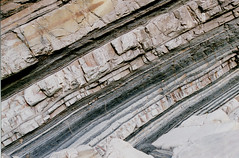| 11857001094 | Lithosphere | A rigid layer made up of the uppermost part of the mantle and the crust. |  | 0 |
| 11857001095 | Convection | The transfer of heat by the movement of a fluid |  | 1 |
| 11857006395 | hot spot | An area where magma from deep within the mantle melts through the crust above it |  | 2 |
| 11857007800 | Island Arc Volcano | Older, dense plate sinks below the younger one. Can cause a chain of islands |  | 3 |
| 11857009820 | subduction zone | The region where oceanic plates sink down into the asthenosphere. |  | 4 |
| 11857012242 | convergent plate boundary | A tectonic plate boundary where two plates collide, come together, or crash into each other. |  | 5 |
| 11857012243 | divergent plate boundary | an area beneath the ocean where tectonic plates move away from each other |  | 6 |
| 11857013511 | transform plate boundary | Boundary between two plates that are sliding past each other. |  | 7 |
| 11857015408 | Ring of Fire | A major belt of volcanoes that rims the Pacific Ocean |  | 8 |
| 11857017792 | Epicenter | Point on Earth's surface directly above an earthquake's focus |  | 9 |
| 11857020488 | Richter scale | A scale that rates an earthquake's magnitude based on the size of its seismic waves. |  | 10 |
| 11857022597 | igneous rock | a type of rock that forms from the cooling of molten rock at or below the surface |  | 11 |
| 11857022598 | Extrusive | fine-grained igneous rock that forms when magma cools quickly at or near Earth's surface |  | 12 |
| 11857027687 | intrusive | a type of igneous rock that generally contains large crystals and forms when magma cools slowly beneath Earth's surface. |  | 13 |
| 11857029143 | sedimentary rock | A type of rock that forms when particles from other rocks or the remains of plants and animals are pressed and cemented together |  | 14 |
| 11857031325 | metamorphic rock | A type of rock that forms from an existing rock that is changed by heat, pressure, or chemical reactions. |  | 15 |
| 11857031326 | Erosion | Processes by which rock, sand, and soil are broken down and carried away (i.e. weathering, glaciation) |  | 16 |
| 11857034725 | O horizon | The organic horizon at the surface of many soils, composed of organic detritus in various stages of decomposition |  | 17 |
| 11857038032 | A soil horizon | The layer of soil that differs in color and texture from the layers above or below it. |  | 18 |
| 11857039556 | E horizon | The zone of leaching that forms under the O horizon or, less often, the A horizon. |  | 19 |
| 11857041923 | B horizon | A soil horizon composed primarily of mineral material with very little organic matter |  | 20 |
| 11857041924 | C horizon | The least-weathered soil horizon, which always occurs beneath the B horizon and is similar to the parent material. |  | 21 |
| 11857048256 | ore | a rock that contains a large enough concentration of a mineral making it profitable to mine |  | 22 |
| 11857050869 | tailings | piles of gangue, which is the waste material that results from mining. |  | 23 |
APES Vocab Flashcards
Primary tabs
Need Help?
We hope your visit has been a productive one. If you're having any problems, or would like to give some feedback, we'd love to hear from you.
For general help, questions, and suggestions, try our dedicated support forums.
If you need to contact the Course-Notes.Org web experience team, please use our contact form.
Need Notes?
While we strive to provide the most comprehensive notes for as many high school textbooks as possible, there are certainly going to be some that we miss. Drop us a note and let us know which textbooks you need. Be sure to include which edition of the textbook you are using! If we see enough demand, we'll do whatever we can to get those notes up on the site for you!

